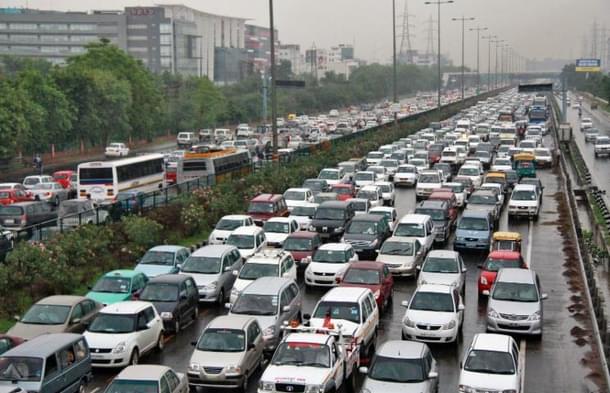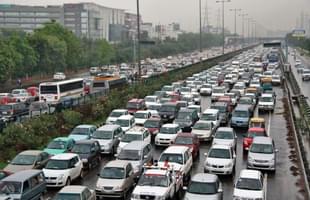Ideas
India Has Nearly As Many Vehicles As Households; Bus Karo! India Cannot Be Car Country Like US
R Jagannathan
Apr 18, 2017, 12:30 PM | Updated 12:30 PM IST
Save & read from anywhere!
Bookmark stories for easy access on any device or the Swarajya app.


India is motorising personal transport at a rate it simply cannot afford. In 2016-17, it produced nearly 20 million passenger vehicles – including cars and two-wheelers, but not three-wheelers – taking the country’s total registered non-commercial vehicle population to around 220 million.
The vehicles on the road (especially if you add three-wheelers and commercial vehicles) are now comparable to the total number of households in India (around 250 million). It implies, in theory, that every household has a vehicle, though averages will deceive because a few people and organisations may own multiple vehicles while millions of poor households may have nothing. But the implication is clear: since Indians rarely scrap vehicles before they are 10-15 years old, we are reaching saturation point in terms of our infrastructure’s ability to handle such volumes.
If our rapidly urbanising country is not to fall apart under traffic congestion and vehicular pollution, we have to reverse this trend, particularly in cars.
India’s car sales crossed the three million mark in 2016-17 despite the demand crunch of demonetisation. While this is a cause for celebration for the domestic automobile industry, it signals the total bankruptcy of public policy in human transportation.
India cannot be car country like the US. When you have four times the population living in a third of the land area, you cannot be. While people will always aspire to own cars or motorbikes, both for status and convenience, state policy must encourage public transport, buses and taxis, not cars and motorbikes.
Of late, there has been a tendency to tout metro railway projects as the answer to urban commuting woes, but here too the reality is different. The huge success of the first phase of the Delhi Metro, which was completed well before time and with minimal cost over-runs, has made some urbanised states believe that metros are the answer. They forget that Delhi is unique, where the central government deals with land and substantially bankrolls a high-cost metro. This situation does not exist in other states, whose metropolitan centres need to obtain substantial commercial funds for both land acquisition and construction in congested spaces. Delhi has lots of road spaces under which metros can be built; but can Mumbai or Kolkata do so with their more limited road spaces?
Experience from metro projects the world over suggests that not only do costs inflate hugely, but the required traffic to sustain a viable metro is far lower than estimated. Tariffs are never high enough to make metros viable in most cases.
Given this context, one cannot see metros as the panacea for urban mass transportation. They can, at best, be a part of the solution in some cities with enough land available. The focus needs to be on augmenting the fleet of public and private bus services, which are not only cheaper to acquire, but can also use urban roads more economically. Metros surely need to be built, but they may often not be viable. They should be built only in places where traffic may be extraordinarily dense and the cost of land is reasonable – not an easy combination to find. Put simply, metros may work better in connecting city centres with satellite towns than inside existing urban megalopolises. Buses must take up the job where metros terminate.
A sensible public transport policy must have two crucial legs: one is to disincentivise private ownership and daily use of cars and two-wheelers; and the other is to promote bus travel, by making many types of buses (basic, luxury, standees-only) available at frequent intervals, if needed with state subsidies. These subsidies can be financed by taxing cars much more heavily than they are now, and by introducing road usage fees and congestion surcharges, not to speak of higher yearly registration fees. The current system of one-time registration fees is too little, and offers no deterrence to widespread ownership and use of cars on urban roads.
Put another way, no public transport policy can work without disincentivising personal transport vehicles. Those who need cars should be encouraged to use app-based taxi services like Uber and Ola, not to speak of regular state-licensed radio and non-radio taxis. Taxis, by plying several trips during the day, reduce the overall volume of cars on roads.
Disincentivising ownership also means levying high parking fees and user charges for private cars plying on busy roads. If London has a congestion surcharge, why not Mumbai, Kolkata or Bengaluru? The remedy is not to build more roads and more parking lots – though these are also needed – but to favour public transport in the use of this infrastructure. The purpose of levying high charges on cars and two-wheelers is not necessarily to earn more revenues for the exchequer, but to cross-subsidise buses and, where reasonably viable, even metro projects.
Any policy must also start taxing two-wheelers. The current tendency is to treat two-wheelers as some kind of poor man’s vehicle, but given the huge growth in two-wheelers on city roads, two or three of them occupy as much road space as cars, especially when they are moving fast. Moreover, given the speeds at which they are driven, they are accident-prone, and impose costs on society that we do not even begin to calculate. Any increase in motorised transport taxes, including highway tolls, should not exclude two-wheelers.
A country of 1.3 billion people, and with rapidly congesting urban spaces, cannot privilege private vehicle usage.
Jagannathan is former Editorial Director, Swarajya. He tweets at @TheJaggi.





